OS29.【Linux】文件IO (1) open、write和close系统调用
目录
1.复习
2.区分C语言的字符串和文件中的字符串
3.三个默认打开的流
示例代码
使用系统调用操作文件
open
宏的组合
原理解释
使用方法
第3个参数mode
mode_t的类型解释
使用
方法1:使用系统调用临时设置umask+0666
方法2:使用系统调用临时设置umask+S开头的宏
close
write
ssize_t类型的解释
使用
write默认从文件起始位置写入
截断写入
追加写入
4.回顾C语言fopen的第二个参数
mode和宏的对应
1.复习
1.在OS2.【Linux】基本指令入门(1)文章讲过: 文件=文件内容+文件属性
2.文件可以按是否打开进行分类 1.打开的文件 2.未打开的文件(在磁盘上)
文件打开需要借助进程,因此研究打开的文件必定研究进程和文件的关系
那么未打开的文件需要借助进程转为打开的文件,需要先找到文件,然后将文件载入内存(这是冯依诺曼体系结构规定的)让进程处理
3.C语言的文件操作参见以下文章回顾:
74.【C语言】文件操作(1)
75.【C语言】文件操作(2)
77.【C语言】文件操作(3)
79.【C语言】文件操作(4)
88.【C语言】文件操作(5)
89.【C语言】文件操作(6)
提醒: 使用fopen()打开文件的路径和文件名,默人在当前路径下新建一个文件,之前讲过当前路径可以在进程的cwd中获取,也可以通过修改cwd(比如chdir系统调用)来修改文新建的位置
4.由之前的C语言的文件操作知识可知: 一个进程可打开多个文件,而操作系统上有大量进程,这些进程多多少少都需要打开一些文件,那么操作系统内部一定有大量打开的文件
5.为了管理好这些打开的文件,需要先描述再组织,可以使用结构体,而结构体中可以填写文件的属性(具体细节后面会写)
6.输出重定向和输入重定向符: 参见OS3.【Linux】基本指令入门(2)文章
注意:单个的输出重定向符号>会先清空文件,而不是追加
从文件打开的模式来看:重定向符号>以w(截断)模式写入,即清空文件并从头开始写入,而>>以a(追加)模式写入
2.区分C语言的字符串和文件中的字符串
例如以下代码:
#include <stdio.h>
#include <string.h>
int main()
{const char* str="teststring";//FILE * fopen ( const char * filename, const char * mode );FILE* fptr=fopen("test.txt","w");//w选项会先清空文件if (fptr==NULL){perror("fopen fail");return -1;}//size_t fwrite ( const void * ptr, size_t size, size_t count, FILE * stream );fwrite(str,strlen(str)+1,1,fptr);fclose(fptr);return 0;
}运行结果:使用HxD打开test.txt

Ubuntu服务器下用nano打开:

Win11:

Win10:

Win7:
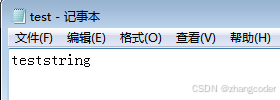
WinXP:
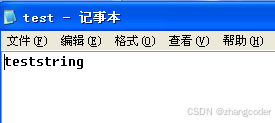
Win2003:
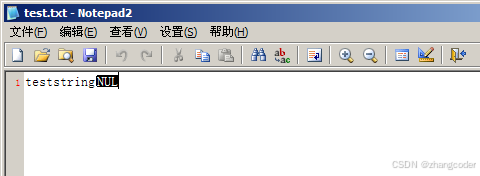
可以看到:如果文本的字符串加了\0,\0对于用户来说是不可见字符,但却被某些系统解释为了乱码,
Linux操作系统上的文件写入null(\0)以后就会乱码,而windows能正常检查到null的
因此不建议使用strlen(str)+1向文本文件写入格式化的字符串!
结论: C语言的字符串会以\0结尾,但是文件中的字符串并没有规定要以\0结尾
3.三个默认打开的流
如果C程序有stdio库,那么在运行时会默认打开3个流,它们的类型都是FILE*,则stdin、stdout和stderr都指向文件)
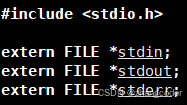
stdin指向键盘文件
stdout:指向显示器文件
stderr:指向显示器文件
示例代码
向终端写入字符可以向stdout写入,可以借助fprintf:
int fprintf(FILE *restrict stream,const char *restrict format, ...);除了第一个参数是文件指针,其余的参数和printf相同
例如以下代码:
#include <stdio.h>
int main()
{fprintf(stdout,"Hello World!\n");return 0;
}
运行结果:

使用系统调用操作文件
前面讲过: 未打开的文件是放在磁盘上的,想要打开文件就要访问磁盘,而磁盘属于硬件
回顾之前在OS16.【Linux】冯依诺曼体系结构和操作系统的浅层理解文章提到的图:

程序不能直接访问硬件 ,因为操作系统不能让用户访问硬件,防止破坏系统,那么打开文件需要系统调用的帮忙
open
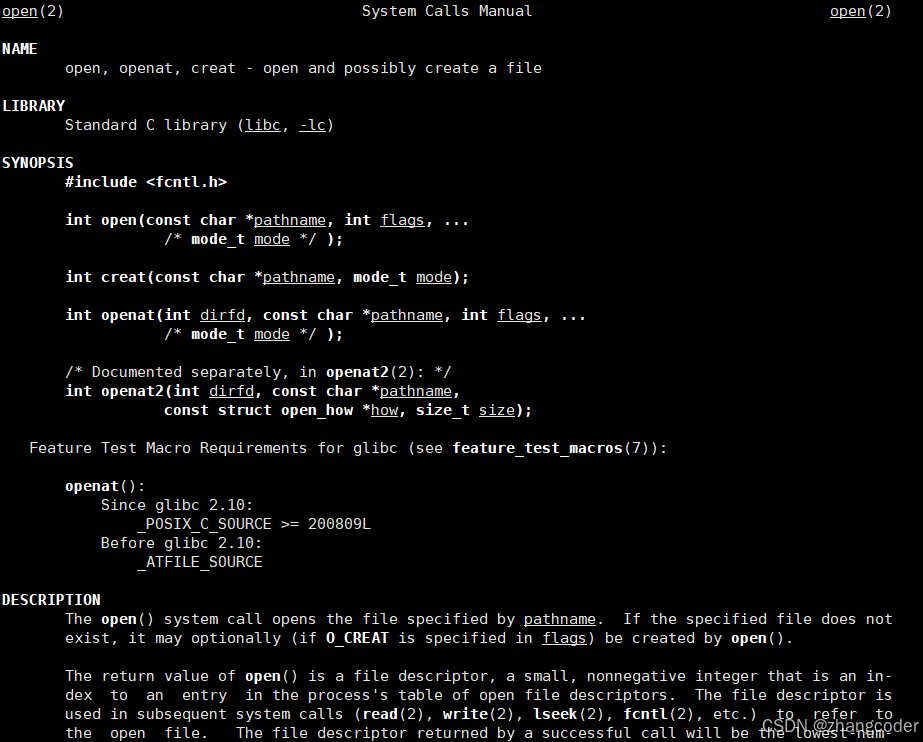
需要包含<fcntl.h>
open系统调用作用: 打开或创建文件,返回值为文件描述符(含义后面讲),如果open系统调用失败,返回-1
建议:
如果文件已经存在,建议用int open(const char *pathname, int flags);
如果要新建文件再打开,建议用int open(const char *pathname, int flags, mode_t mode);
注:
1.pathname是文件路径
2.flags可以选 O_ASYNC、O_CLOEXEC、O_CREAT、O_DIRECT、......
本文讲O_RDONLY、O_WRONLY、 O_RDWR、O_CREAT、O_TRUNC、O_APPEND用法
O_RDONLY全称Open_ReaDONLY(只读)
O_WRONLY全称Open_WriteONLY(只写)
O_RDWR全称Open_ReaDWRite(读+写)
O_CREAT全称Open_CREAT(新建文件)
上面大写的其实是宏,可以在glibc-2.4.2的bits/fcntl.h中找到
/* File access modes for `open' and `fcntl'. */ #define O_RDONLY 0 /* Open read-only. */ #define O_WRONLY 1 /* Open write-only. */ #define O_RDWR 2 /* Open read/write. *//* Bits OR'd into the second argument to open. */ #define O_CREAT 0x0200 /* Create file if it doesn't exist. */ #define O_EXCL 0x0800 /* Fail if file already exists. */ #define O_TRUNC 0x0400 /* Truncate file to zero length. */ #define O_NOCTTY 0x8000 /* Don't assign a controlling terminal. */ #define O_ASYNC 0x0040 /* Send SIGIO to owner when data is ready. */ #define O_FSYNC 0x0080 /* Synchronous writes. */ #define O_SYNC O_FSYNC #ifdef __USE_MISC #define O_SHLOCK 0x0010 /* Open with shared file lock. */ #define O_EXLOCK 0x0020 /* Open with shared exclusive lock. */ #endif #ifdef __USE_XOPEN2K8 # define O_DIRECTORY 0x00200000 /* Must be a directory. */ # define O_NOFOLLOW 0x00000100 /* Do not follow links. */ # define O_CLOEXEC 0x00400000 /* Set close_on_exec. */ #endif #if defined __USE_POSIX199309 || defined __USE_UNIX98 # define O_DSYNC 0x00010000 /* Synchronize data. */ # define O_RSYNC 0x00020000 /* Synchronize read operations. */ #endif
宏的组合
例如定义以下宏:
#define ONE (1)
#define TWO (2)
#define FOUR (4)
#define EIGHT (8)可以使用或运算符组合这些宏(比特方式传递标志位),例如以下代码:
int main()
{int flags=ONE|FOUR|EIGHT;if (flags&ONE)printf("1\n");if (flags&TWO)printf("2\n");if (flags&FOUR)printf("4\n");if (flags&EIGHT)printf("8\n");return 0;
}
运行结果:

原理解释
上方代码定义的宏都有一个特点,都是从1左移而来的
1==1<<0
2==1<<1
4==1<<2
8==1<<3当flags=ONE|FOUR|EIGHT时,执行到if (flags&ONE)时,有:
ONE|FOUR|EIGHT&ONE
==(1<<0)|(1<<2)|(1<<3)&(1<<0)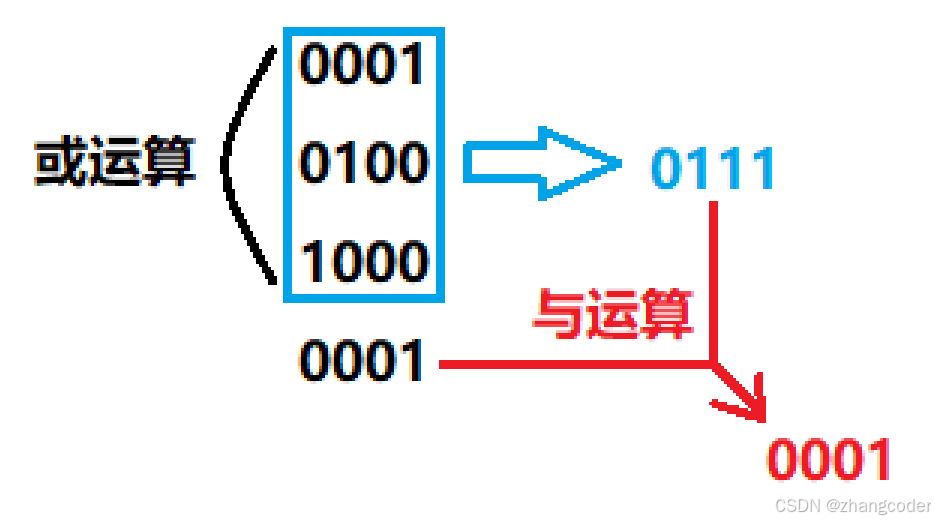
bits/fcntl.h也有这样使用或运算组合的定义:
/* Mask for file access modes. This is system-dependent in casesome system ever wants to define some other flavor of access. */
#define O_ACCMODE (O_RDONLY|O_WRONLY|O_RDWR)//组合了3个功能注:宏必须是2的次方才可以使用位运算组合宏,bits/fcntl.h中的flags宏也是这样定义的,不是2的次方的情况可以自行验证
使用方法
例如以只读形式打开:
int fd=open("test.txt",O_RDONLY);
if (fd==-1)
{perror("open failed");return -1;
}例如以读+写的形式打开:
既可以用或运算组合功能:
int fd=open("test.txt",O_RDONLY|O_WRONLY);
if (fd==-1)
{perror("open failed");return -1;
}也可以直接使用单个宏:
int fd=open("test.txt",O_RDWR);
if (fd==-1)
{perror("open failed");return -1;
}例如创建文件:
int fd=open("test.txt",O_CREAT);
if (fd==-1)
{perror("open failed");return -1;
}使用上面的法在某些情况下会出问题,文件权限有问题:
![]()
这就要谈谈mode的作用了
第3个参数mode
mode_t的类型解释
mode的类型是mode_t,后者是被重定义的,真正的类型见下方在glibc-2.42中的查找过程:
在posix/bits/types.h中:
#ifndef __mode_t_defined
typedef __mode_t mode_t;
# define __mode_t_defined
#endif在posix/bits/types.h中:
__STD_TYPE __MODE_T_TYPE __mode_t; /* Type of file attribute bitmasks. */在bits/types.h中:
#define __MODE_T_TYPE __U32_TYPE在posix/bits/types.h中:
#define __U32_TYPE unsigned int结论:mode_t是无符号整型
使用
新建文件必须告知权限,要写open系统调用的第3个参数mode,如果不临时设置umask,第3个参数mode会和mask进行位运算得到文件真正的权限(位运算具体方法参见OS9.【Linux】基本权限(下)文章)
#include <stdio.h>
#include <fcntl.h>
int main()
{int fd=open("test.txt",O_CREAT,0666);if (fd==-1){perror("open failed");return -1;}return 0;
}运行结果:新建的文本文件的权限仍然不正确,不是-rw-rw-rw-
![]()
两种解决方法:
方法1:使用系统调用临时设置umask+0666
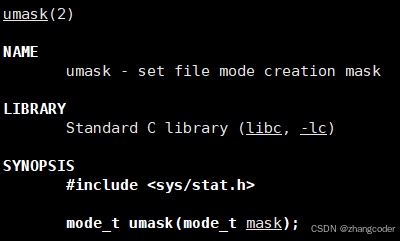
umask系统调用返回曾经的umask值
让实际的文件权限变成666:
#include <stdio.h>
#include <fcntl.h>
#include <sys/stat.h>
int main()
{umask(0);int fd=open("test.txt",O_CREAT,0666);//必须是八进制,有前导0!if (fd==-1){perror("open failed");return -1;}return 0;
}
注:根据就近原则,代码中设置了umask(0),那么不考虑系统的umask值,而且umask(0)不影响系统的umask值,可以看看手册中的具体描述:
umask() sets the calling process's file mode creation mask (umask) to mask & 0777 (i.e., only the file permission bits of mask are used), and returns the previous value of the mask.
运行结果:
![]()
方法2:使用系统调用临时设置umask+S开头的宏
当然也可以用其他方法,参见https://linuxvox.com/blog/linux-open-system-call/网站的摘抄:
mode: This parameter is only used when theO_CREATflag is specified. It specifies the permissions to be set for the newly created file. The permissions are specified using a combination of the following constants:S_IRUSR(read permission for the owner),S_IWUSR(write permission for the owner),S_IXUSR(execute permission for the owner),S_IRGRP(read permission for the group),S_IWGRP(write permission for the group),S_IXGRP(execute permission for the group),S_IROTH(read permission for others),S_IWOTH(write permission for others), andS_IXOTH(execute permission for others).
解释:mode模式仅当指定O_CREAT才使用,mode是设置新建文件的权限的,具体可以见S开头
POSIX标准(见https://pubs.opengroup.org/onlinepubs/9799919799/basedefs/sys_stat.h.html)给了一张表:
| Name | Numeric Value | Description |
|---|---|---|
| S_IRWXU | 0700 | Read, write, execute/search by owner.(拥有者有读、写、执行/搜索的权限) |
| S_IRUSR | 0400 | Read permission, owner.(拥有者有读的权限) |
| S_IWUSR | 0200 | Write permission, owner.(拥有者有写的权限) |
| S_IXUSR | 0100 | Execute/search permission, owner.(拥有者有执行/搜索的权限) |
| S_IRWXG | 070 | Read, write, execute/search by group.(所属组有读、写、执行/搜索的权限) |
| S_IRGRP | 040 | Read permission, group.(所属组有读的权限) |
| S_IWGRP | 020 | Write permission, group.(所属组有写的权限) |
| S_IXGRP | 010 | Execute/search permission, group.(所属组有执行/搜索的权限) |
| S_IRWXO | 07 | Read, write, execute/search by others.(其他人有读、写、执行/搜索的权限) |
| S_IROTH | 04 | Read permission, others.(其他人有读的权限) |
| S_IWOTH | 02 | Write permission, others.(其他人有写的权限) |
| S_IXOTH | 01 | Execute/search permission, others.(其他人有执行/搜索的权限) |
| S_ISUID | 04000 | Set-user-ID on execution.(执行时设置用户ID) |
| S_ISGID | 02000 | Set-group-ID on execution.(执行时设置组ID) |
| [XSI] S_ISVTX | 01000 | On directories, restricted deletion flag.(为目录设置受限删除标志) |
宏开头的S指Symbolic,即符号的
那么要创建rw-rw-rw-的文件可以用或运算组合宏:
#define S_FILE S_IRUSR | S_IWUSR | S_IRGRP | S_IWGRP | S_IROTH | S_IWOTH
#include <stdio.h>
#include <fcntl.h>
#include <sys/stat.h>
int main()
{umask(0);int fd=open("test.txt",O_CREAT,S_FILE);if (fd==-1){perror("open failed");return -1;}return 0;
}
注意: S_FILE仍然要和umask做位运算得到真正的文件权限
close
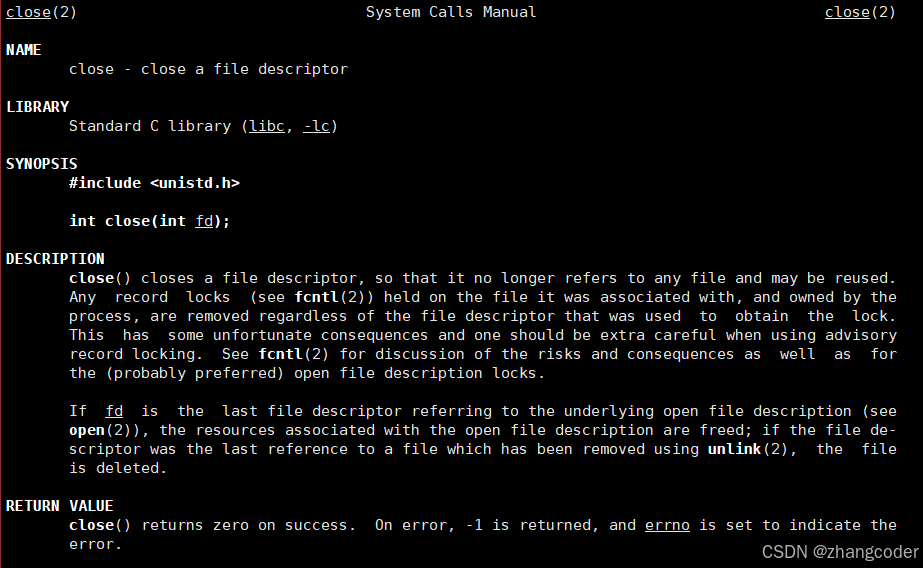
close系统调用作用: 依照文件描述符关闭指定文件
注意检查返回值是否为-1
write
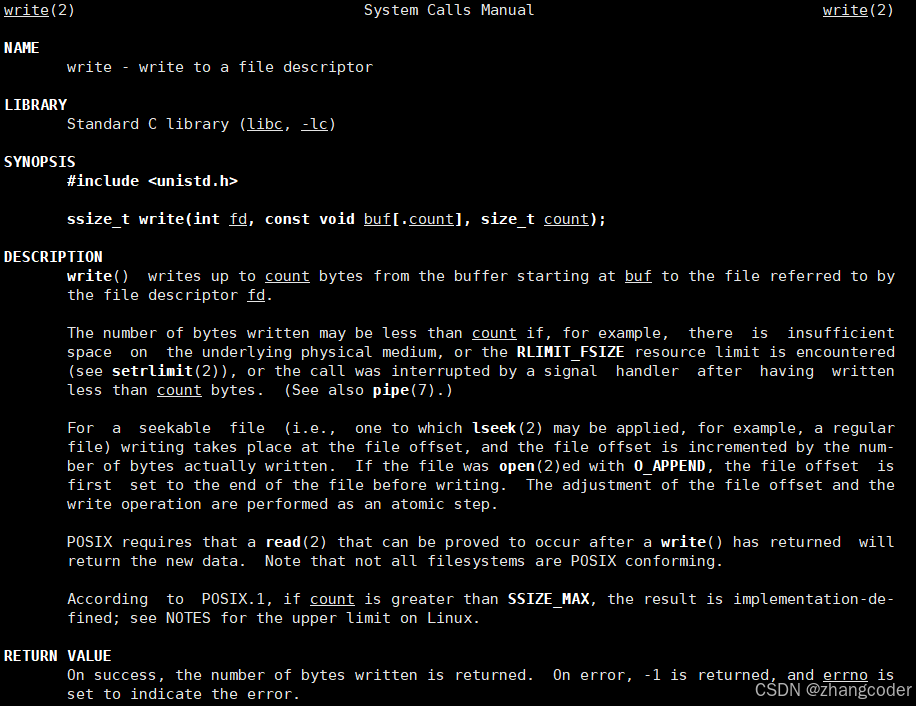
需要包含<unistd.h>
write系统调用作用: 向一个文件描述符写入,即写入文件时需要依靠文件描述符
ssize_t write(int fd, const void buf[.count], size_t count);
第一个参数是文件描述符,第二个参数是从buf数组,要从此处取数据,第三个参数是要写入的字节数,返回值是ssize_t
ssize_t类型的解释
glibc-2.42库中有定义:
在posix/sys/type.h中:
#ifndef __ssize_t_defined
typedef __ssize_t ssize_t;
#define __ssize_t_defined
#endif在sysdeps/generic/_G_config.h中:
#define _G_ssize_t ssize_t在bits/types.h中:
__STD_TYPE __SSIZE_T_TYPE __ssize_t;在bits/typesizes.h中:
#define __SSIZE_T_TYPE __SWORD_TYPE在posix/bits/type.h中:
#if __WORDSIZE == 32
# define __SQUAD_TYPE __int64_t
# define __UQUAD_TYPE __uint64_t
# define __SWORD_TYPE int
# define __UWORD_TYPE unsigned int
# define __SLONG32_TYPE long int
# define __ULONG32_TYPE unsigned long int
# define __S64_TYPE __int64_t
# define __U64_TYPE __uint64_t
/* We want __extension__ before typedef's that use nonstandard base typessuch as `long long' in C89 mode. */
# define __STD_TYPE __extension__ typedef
#elif __WORDSIZE == 64
# define __SQUAD_TYPE long int
# define __UQUAD_TYPE unsigned long int
# define __SWORD_TYPE long int
# define __UWORD_TYPE unsigned long int
# define __SLONG32_TYPE int
# define __ULONG32_TYPE unsigned int
# define __S64_TYPE long int
# define __U64_TYPE unsigned long int
/* No need to mark the typedef with __extension__. */
# define __STD_TYPE typedef
#else
# error
#endif看到__SWORD_TYPE有两种定义方式:
# define __SWORD_TYPE int //#if __WORDSIZE == 32
# define __SWORD_TYPE long int //#elif __WORDSIZE == 64结论:ssize_t的大小和系统架构有关,可以是int,也可以是long int
使用
open返回文件描述符,可以传入write
#include <stdio.h>
#include <fcntl.h>
#include <sys/stat.h>
#include <string.h>
#include <unistd.h>
int main()
{umask(0);int fd=open("test.txt",O_CREAT|O_WRONLY,0666);//必须是八进制,有前导0!if (fd==-1){perror("open failed");return -1;}const char arr[]="teststring\n";if (write(fd,arr,strlen(arr))==-1)//不用写成strlen(arr)+1{perror("write failed");return -1;}if (close(fd)==-1){perror("close failed");return -1;}return 0;
}
注:O_WRONLY是必须要加的,否则进程对test.txt没有写权限
运行结果:

write默认从文件起始位置写入
将上方代码的const char arr[]="teststring\n",改成const char arr[]="abcd"后执行:
可以看到前4个字符被替换了,证明write本身默认从文件起始位置写入,不会先清空文件后写入(open第二个参数没有添加其他的功能)

截断写入
修改上方代码: int fd=open("test.txt",O_CREAT|O_WRONLY|O_TRUNC,0666),const char arr[]="a\n"后执行:
可以看到原来的字符串消失了:

O_TRUNC的功能:打开文件时会清空文件(也称截断文件)

追加写入
修改上方代码: int fd=open("test.txt",O_CREAT|O_WRONLY|O_APPEND,0666),const char arr[]="bc\n"后执行:
可以看到在原文件的基础上追加写入了新字符串:
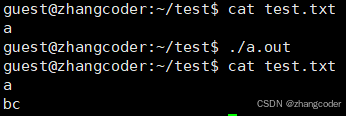
O_APPEND的功能:追加写入打开的文件
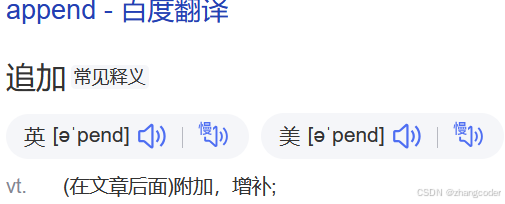
4.回顾C语言fopen的第二个参数
FILE * fopen ( const char * filename, const char * mode );可以推出Linux下的fopen函数的内部一定使用了open系统调用
mode和宏的对应
从glibc-2.42库来看:
在include/stdio.h中:
#if IS_IN (libc)
extern FILE *_IO_new_fopen (const char*, const char*);
#define fopen(fname, mode) _IO_new_fopen (fname, mode)在libio/iofopen.c中:
FILE* _IO_new_fopen (const char *filename, const char *mode)
{return __fopen_internal(filename, mode, 1);
}在libio/iofopen.c中,__fopen_internal函数并没有显式使用open系统调用:
FILE *
__fopen_internal (const char *filename, const char *mode, int is32)
{struct locked_FILE{struct _IO_FILE_plus fp;
#ifdef _IO_MTSAFE_IO_IO_lock_t lock;
#endifstruct _IO_wide_data wd;} *new_f = (struct locked_FILE *) malloc (sizeof (struct locked_FILE));if (new_f == NULL)return NULL;
#ifdef _IO_MTSAFE_IOnew_f->fp.file._lock = &new_f->lock;
#endif_IO_no_init (&new_f->fp.file, 0, 0, &new_f->wd, &_IO_wfile_jumps);_IO_JUMPS (&new_f->fp) = &_IO_file_jumps;_IO_new_file_init_internal (&new_f->fp);if (_IO_file_fopen ((FILE *) new_f, filename, mode, is32) != NULL)return __fopen_maybe_mmap (&new_f->fp.file);_IO_un_link (&new_f->fp);free (new_f);return NULL;
}在libio/fileops中,只看_IO_new_file_fopen内主要部分:
switch (*mode){case 'r':omode = O_RDONLY;read_write = _IO_NO_WRITES;break;case 'w':omode = O_WRONLY;oflags = O_CREAT|O_TRUNC;read_write = _IO_NO_READS;break;case 'a':omode = O_WRONLY;oflags = O_CREAT|O_APPEND;read_write = _IO_NO_READS|_IO_IS_APPENDING;break;default:__set_errno (EINVAL);return NULL;}//......for (i = 1; i < 7; ++i){switch (*++mode){case '\0':case ',':break;case '+':omode = O_RDWR;read_write &= _IO_IS_APPENDING;last_recognized = mode;continue;case 'x':oflags |= O_EXCL;last_recognized = mode;continue;case 'b':last_recognized = mode;continue;case 'm':fp->_flags2 |= _IO_FLAGS2_MMAP;continue;case 'c':fp->_flags2 |= _IO_FLAGS2_NOTCANCEL;continue;case 'e':oflags |= O_CLOEXEC;fp->_flags2 |= _IO_FLAGS2_CLOEXEC;continue;default:/* Ignore. */continue;}break;}mode见下表:
C string containing a file access mode. It can be:
| "r" | read: Open file for input operations. The file must exist. |
| "w" | write: Create an empty file for output operations. If a file with the same name already exists, its contents are discarded and the file is treated as a new empty file. |
| "a" | append: Open file for output at the end of a file. Output operations always write data at the end of the file, expanding it. Repositioning operations (fseek, fsetpos, rewind) are ignored. The file is created if it does not exist. |
| "r+" | read/update: Open a file for update (both for input and output). The file must exist. |
| "w+" | write/update: Create an empty file and open it for update (both for input and output). If a file with the same name already exists its contents are discarded and the file is treated as a new empty file. |
| "a+" | append/update: Open a file for update (both for input and output) with all output operations writing data at the end of the file. Repositioning operations (fseek, fsetpos, rewind) affects the next input operations, but output operations move the position back to the end of file. The file is created if it does not exist. |
从_IO_new_file_fopen得知:
"r"对应O_RDONLY
"w"对应O_CREAT|O_TRUNC|O_WRONLY
"a"对应O_CREAT|O_APPEND|O_WRONLY
"r+"对应O_RDWR
"w+"对应O_RDWR
"a+"对应O_RDWR
结论:各种语言的打开或者和关闭等文件操作函数在Linux系统下封装了open/close等系统调用
